When Modern Landscaping Practices Kill Perfectly Good Plants
I spent the day pulling up thousands of dollars worth of tea olive and other shrubs, then filling a 33 foot long dumpster with them. 15 feet wide and 250 feet long, the shrub border that failed was planted 5 years ago, with really nice plants, by someone else. It’s a shame, it makes me sad and mad and it’s costing the owner a lot of money.
I got the call to come and help, to figure out the problems and design a new shrub border. The success of my border design depended on figuring out the failures of the previous border — here’s what I found:
The main problem was a desire for an instant landscape. Someone wanted it big and now. Based on the history, I’m guessing a real estate agent prompted this. So, some landscape company used all the tricks of the trade to satisfy that goal. They actually did things right, according to standard practices. There was even some follow up, some after care. Just not the right kind. So, here’s my analysis of what went wrong and my hope that anyone reading this will avoid cheap tricks, short term solutions and build themselves a real garden.
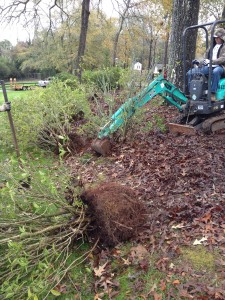
You can see the light mix used in the nursery and after 5 years, the roots are still in the shape of the pot.
1. Big, fast grown plants produced in a nursery factory. In the Louisiana nursery they came from, the plants got
constant drip irrigation and fertigation. Basically, they were on steroids. To live like this, the “soil” in the plastic pot had to drain perfectly. It was as is often the case, basically pine bark. When planted in the ground, the roots couldn’t adapt. And the pinebark in the root ball actually kept those roots in a really dry environment. Once dry, it would have been impossible to ever get it wet again.
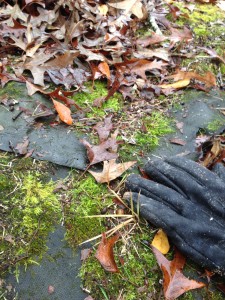
The landscape fabric excluded water and nutrients. (note the moss which also indicates acid conditions)
2. Landscape fabric is the dumbest idea ever. It’s one of those things that seems like a great idea, so people buy it. In this case, the landscape fabric further excluded water, further drying the roots. It also excluded nutrients and organic matter from the beautiful mulch of leaves that falls on the area each fall. The leaves rot on top of the fabric, the poor dying plants in a desperate attempt to live somewhere moist, grow over the mat. Weeds also grow over the mat. So everything, the big beautiful plants and the weeds are now competing in a thin mat of roots on top of a thick piece of fabric, while the ground, the dirt, the earth, is segregated and drying below the fabric.
3. Sublimation to Irrigation. Well, it’s not the system that caused a problem. It that someone trusted the system too much. You can’t just turn irrigation on, set the auto clock and walk away. I’m sure this system was merrily spraying delightful mist of water three times a week. It probably looked really good — at a glance. But it wasn’t wetting the soil or the roots — and that’s what needs water. It’s like telling a child to feed the dog, never following up, then wondering why the dog is skin and bones.
4. Plants planted too deeply basically get strangled. There are lots of reason plants get put in too deeply, but mostly, it’s that desire for the place to look good immediately. Often new plants, especially big ones are wobbly and require staking. But staking is a skill. Not just anyone can do it. And, it require the landscaper come back over the course of the years and remove the stakes and strings. So the easy answer is to plant that thing a little deep, put some extra dirt on it and it will stand up without stakes and string. The plants in this shrub border were six to eight inches deep. Literally, they were strangled.
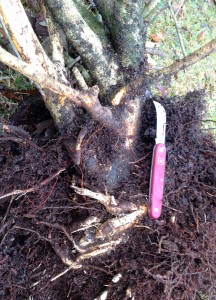
Not only was it planted too deeply 5 years ago, but 5 years before that, the roots were tangled and twisted in the nursery.
By the end of the day, we’d pulled up hundreds of plants of all types. We’ll avoid lots of these problems and already have started. First, we’re pulling up the landscape fabric. Second were adding proper soil nutrients including lots of pulverized lime. And, all new plants get drenched, drenched and drenched again seaweed fertilizer. Oh, basically, we’re doing everything differently. Here’s what the place looked like at the end of day one. I’ll post pics over the next few days of the planting.
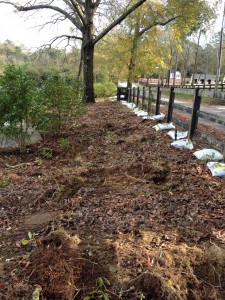
Though the 5 camellias are healthy, we’ve scraped about 3 inched of soil off them and removed the landscape fabric.


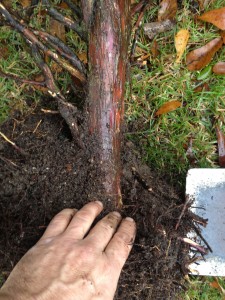
These kinds of descriptions and photos are fantastic for homeowners who often have little information to rely on when they’re trying to lay out a landscape. Too often they’re left with only the claims of a landscaper who may have as little knowledge as the homeowner, and ethics even less. Thanks a million for this, J.
I see you’ve sold out of those gorgeous Narcissus “Hawara” and Tulipa clusiana. That was FAST! Fantastic!
Thanks Will, even well trained landscapers don’t escape some of these pitfalls. Often nursery plants come potted too deep, so you have to remove an inch or so from the root ball before you plant. I hope this doesn’t come off as a rant for the local newspaper!
You are so right, Jenks. I’m still learning the basics (my lesson on landscape fabric was a painful one!), and I’ll never learn it all. Not to mention that “best practices” change with new knowledge and with new situations. Nonetheless, the lessons you cover here in this post – and presumably in followup posts – are essential ones for us all. Learning them can save a bunch of misery and money. The post may be a rant, but I don’t think there’s any danger of it appearing in the papers! Maybe it should!
Thanks for the great post. It reminded me that I used landscape fabric to hold in place a hill of clay created when I built the infrastructure in my garden. We’ve since planted the entire area. Should I try to pull out the fabric now? It’s been in place about 4 years.
Bob, If it doesn’t seem to be hurting anything, just leave it. You know your plants well. And some fabrics break down with time, some allow more water and air movement than others. Since your garden is so spectacular, I’d let it stay.